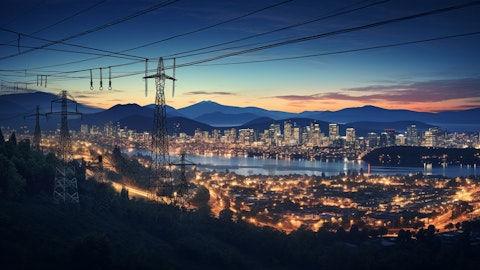Anthony Crowdell: Great. And then, just to stay on the mark with Connecticut questions. I know sometimes when utilities ramp up CapEx or they may be doing some new projects, they talk to policymakers, some regulators prior to it and get a feel of just, hey, the policymakers are on board with this increased capital that they’re spending. I’m curious if something happened in Connecticut where you had some of the discussions on actually the lowering of CapEx.
Joseph Nolan: Yes. We’ve had discussions about our investments. I mean we started talking about AMI three years ago and we’re all on the same page that everybody wanted AMI. We talked about investment in EVs, electric vehicles and infrastructure. So, we were totally aligned with certainly key leaders down there. So, we continue to have that dialogue. And right now, we have dialogue where we share with them that we can’t keep moving forward unless we get the certainty around it. I mean costs have increased since the time we began talking about AMI. If we had got on with the show that would have saved our customers money, but this delay doesn’t help matters. We’re kicking it off here in Massachusetts. We’re going to be putting in AMI meters and infrastructure and the customers are going to benefit from that.
Operator: The next question comes from the line of Durgesh Chopra with Evercore. Your line is now open.
Durgesh Chopra: Good morning. Thanks for giving me time. Hey, John. Just for investors and I was trying to think about the implications if you don’t move forward with the Aquarion water sale. Can you just help clarify what does that do to the equity? Could the equity — if you don’t move forward with the sale, could the equity be higher than $1.3 billion or is that the max? And then if you do a sale that number moves lower?
John Moreira: Well, there’s still a lot of things in flux and I’m not we’re not moving off of the $1.3 billion equity needs until we have more clarity, so as things evolve over the coming year. But right now, our position is to kind of work preparing the potential sale for Aquarion and get through Phase 1 and see what that looks like.
Durgesh Chopra: Understood. And then just to be clear on the FFO to debt, I know a lot of questions have been asked. You get to that 14% to 15% by 2025 with or without the Aquarion sale? Am I thinking about it the right way?
John Moreira: No. No. If you look at the left-hand side of that slide on the bottom, we have other drivers. Those other drivers are cash inflows that we have not quantified. But, yes. We have assumed as I continue to reiterate in our financing plan, we have assumed the sale of Aquarion.
Durgesh Chopra: Perfect. Okay. Then just one hopefully quick follow-up. Anything to kind of note in terms of the construction process or costs, you know, on Revolution and Sunrise? Any updates versus your past disclosures there?
Joseph Nolan: Yeah. I know it’s too early right now, but we continue to stay close to it and, we’ll keep you updated. We did start though. The good news is we’re in the ground and construction is underway. So, we’re excited and we’re going to utilize the same practices that we successfully deployed in the construction of the South Fork project, which as you and all know all 12 of the turbines are up and they’re running. And we’re very, very proud that we had the first offshore wind provider in the United States.
Durgesh Chopra: Perfect. I appreciate you taking my questions and giving me time. Thank you again both.
Operator: Our final question comes from the line of Travis Miller with Morningstar. Your line is now open.
Travis Miller: Good morning. Thanks for taking my questions. Real quick one staying on CL&P here. If you take out your depreciation or maintenance CapEx, how much of that additional CapEx is covered under an existing rider or tracker or something like that outside of a base rate? You mentioned energy efficiency. Is there other CapEx?
John Moreira: The biggest CapEx is the $300 million system hardening that we’ve had in place for quite some time. So that has helped, the timely cost recovery and it’s helped Connecticut get to a much better situation from a reliability standpoint. So, I would say that a good chunk of the as you pointed out, the maintenance depreciation would be covered by that.
Travis Miller: Okay. And then got a real quick following on some of the other questions. Do you expect the clean energy policy overall, it’s not necessarily just the rate setting, but clean energy policy overall in Connecticut will be a political issue this year or is that something for years down the road?
Joseph Nolan: Yes. No, I mean the legislative session is going to end next week. So, I don’t expect that you could see anything at that point. But I think the dialogue will continue as we’ll remain engaged for the rest of this year and into the future until such time as we are all on the same page and we can find out what’s important to this state that we can invest in and get a fair return and fair — really a level playing field. That’s all we’re looking for.
John Moreira: I just want to thank everybody for their time. And please follow-up with IR with any additional follow-up questions that we can help out with. And I’ll turn it back over to Alyssa.
Operator: Thank you. This will conclude today’s conference call. [Operator Closing Remarks].
Follow Eversource Energy (NYSE:ES)
Follow Eversource Energy (NYSE:ES)
Receive real-time insider trading and news alerts




